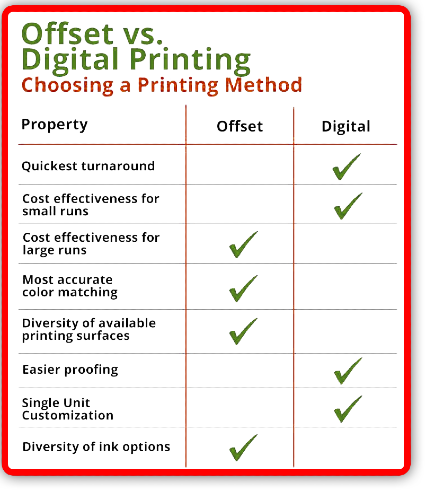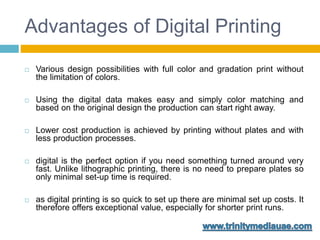The Buzz on Digital Printing
Wiki Article
Digital Printing - The Facts
Table of ContentsNot known Facts About Digital PrintingExcitement About Digital PrintingWhat Does Digital Printing Do?Some Known Factual Statements About Digital Printing Everything about Digital PrintingAll about Digital PrintingThe Single Strategy To Use For Digital Printing
According to PMMI, digital printing allows brands and makers to react swiftly to consumer demands while boosting the supply chain, decreasing warehousing price and waste, and taking pleasure in faster time to market. That all sounds wonderful, but exactly how does this innovation do all that? The significant differentiator of these modern technologies is that there are no set up charges and no plates with electronic printing.According to Wikipedia, the best distinction in between digital printing and conventional techniques such as lithography, flexography, gravure, or letterpress is that there is no demand to change printing plates in digital printing, whereas in these analog printing techniques home plates are consistently replaced. This results in quicker turnaround time and decreases expense when utilizing digital printing.

A Biased View of Digital Printing
A lot more supply can mean even more waste in the future. With conventional printing techniques, short-run printing is just not feasible. Because a terrific design can make or break your item, digital printing constantly creates top quality, clear and vivid graphics each time. Digital printing on flexible pouches includes the intense, dynamic, and exact graphics that practically beckon customers to reach out and touch them.Digital printing is the process of printing digital-based images straight onto a variety of media substrates. There is no need for a printing plate, unlike with balanced out printing. Digital documents such as PDFs or desktop computer publishing data can be sent out directly to the digital printing press to print theoretically, image paper, canvas, textile, synthetics, cardstock and various other substratums.
Digital printing is much faster and efficient in even more detail, two reasons it's usually used to print packaging, direct advertising flyers, and books or magazines. Most digital printing presses have historically used toner-based technology and as that modern technology quickly advanced, the print quality measured up to that of offset presses. In the last few years, inkjet innovation has simplified digital print ease of access along with the cost, speed and quality challenges facing print service providers today.
The 45-Second Trick For Digital Printing
Offset printing is the perfect solution when you need and/or adaptable colour, paper and sizing options. Digital Printing. Digital printing is excellent for jobs, generally much less than 2,000 copies, and when you need a quick turn-around. If you are not certain what's best for your project, we will function with you to pick the print method finest matched to your task and budget plan.The exact color matching and adaptability it provides make it tough to overlook. Digital printing allows for fast and affordable production without endangering quality, unlike balanced out printing. It enables smaller sized print runs and on-demand production, making it optimal for businesses of all dimensions. Furthermore, electronic printing, with its outstanding shade precision and uniformity, is a game-changer in the market.
While both have their benefits, there are a number of essential distinctions that set them apart. Recognizing these differences can aid you make an educated decision concerning which method is best suited for your printing needs. Countered printing has long been the go-to option for high-volume business printing. It entails moving ink from plates to rubber coverings prior to lastly applying it onto the paper.
The Buzz on Digital Printing
One significant benefit of countered printing presses is their capacity to take care of a vast array of paper dimensions and densities. The balanced out press can fit numerous products, consisting of shiny or textured documents, giving adaptability that electronic printers might struggle to match. This printing method depends on the use of printing plates to move the ink onto the paper, making it a popular choice for high-grade prints.The process includes creating plates for each color used in the layout, which can be time-consuming and expensive upfront. Changes might be required throughout the print run to maintain quality uniformity with printing machine. Digital printing, on the other hand, provides an extra structured approach contrasted to balance out press. With this technique, ink is applied straight onto the paper without the requirement for intermediate steps like plate development or rubber blankets.

Let's dive into these benefits and discover how they can profit organizations. One substantial advantage of digital printing is the removal of pricey configuration charges that are linked with countered printing. In conventional countered printing, each job requires the production of plates, which can be pricey and time-consuming. With digital technology, there is no requirement for plates or intricate setup procedures.
7 Simple Techniques For Digital Printing
One more cost-saving aspect of digital printing is the capability to print only original site what you need. Unlike balanced out printing, where big quantities have to be produced to make the procedure financially sensible, electronic printers use greater versatility. Whether you need a small set or a single copy, digital technology enables on-demand printing without any additional expenses.Using conventional offset printing would certainly call for generating a big quantity upfront to attain an acceptable device expense per flyer. However, by opting for electronic printing rather, they can publish only the specific number required at a lower overall cost.: A marketing firm wishes to run a direct-mail advertising campaign targeting different client segments with personalized sales brochures.
Among the essential advantages of digital printing for tiny print runs is its. Unlike offset printing, which needs the development of plates and setup time for each work, electronic printers can begin producing prints virtually promptly. This makes them ideal for smaller sized amounts where time is of the essence.
Some Known Questions About Digital Printing.
One more benefit of digital printing is its ability to create customized marketing materials. With, companies can easily integrate personalized content within each published piece.
One of the vital benefits is the enhanced adaptability and customization choices that include digital printing. With electronic printing, making modifications to designs or web content throughout the manufacturing process is a wind. Unlike traditional offset printing, where making alterations can be time-consuming and costly, electronic innovation permits see this page for quick and simple changes.
Another advantage of electronic printing is its variable data abilities. This attribute enables personalized material to be published on a mass range without compromising performance or quality. Whether you need to personalize each item with individual names, useful site addresses, or other one-of-a-kind information, variable data printing makes it possible. This level of personalization can considerably boost customer engagement and action rates.
Some Known Details About Digital Printing
Whether you're trying to find glossy or matte surfaces, textured documents, or specialty stocks, electronic printers can accommodate different preferences. This convenience guarantees that your printed products straighten with your brand name photo while supplying a visually attractive end outcome. Digital printing genuinely shines. The capacity to change layouts or material during production conserves time and resources compared to conventional offset approaches - Digital Printing.Report this wiki page